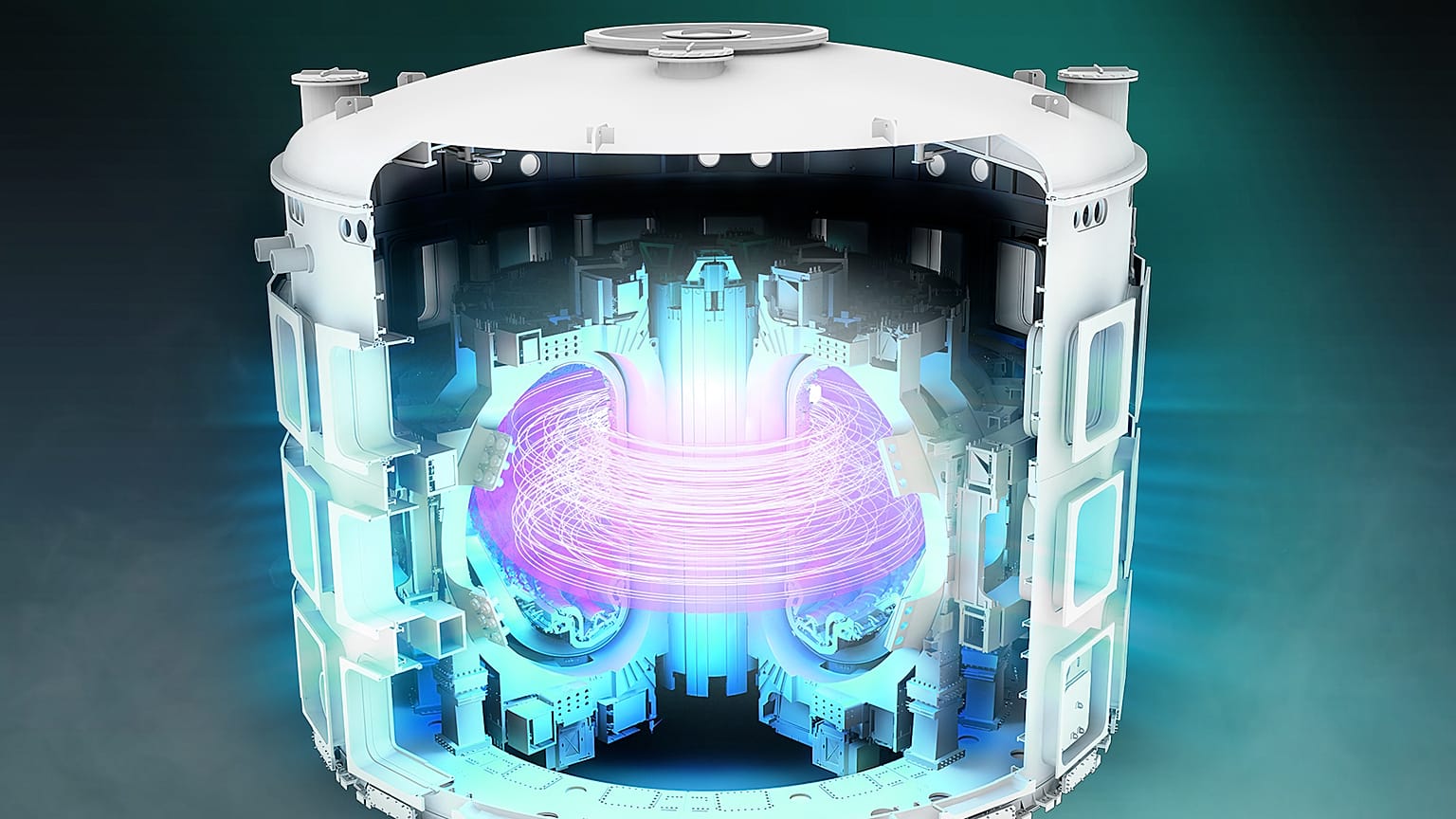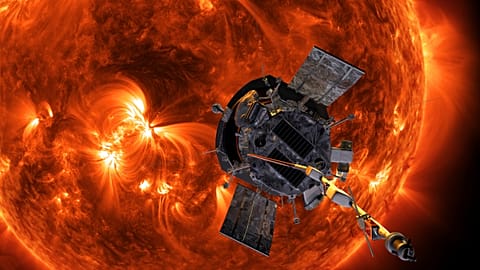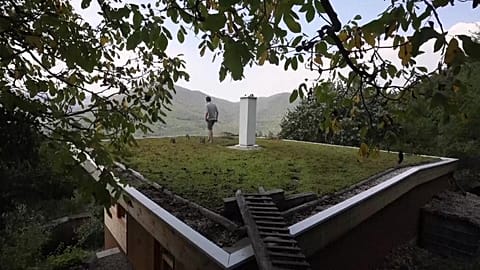Euronews Next went behind the scenes at the world’s largest nuclear fusion device attempting to harness the same reaction that powers the Sun and stars.
 ADVERTISEMENT
ADVERTISEMENT
In the heart of Provence, some of the brightest scientific minds on the planet are setting the stage for what is being called the world’s largest and most ambitious science experiment.
"We are building arguably the most complex machine ever designed," confided Laban Coblentz.
The task at hand is to demonstrate the feasibility of harnessing nuclear fusion - the same reaction powering our Sun and stars - at an industrial scale.
To do this, the world’s largest magnetic confinement chamber, or tokamak, is under construction in the south of France to generate net energy.
The International Thermonuclear Experimental Reactor (ITER) project agreement was formally signed in 2006 by the US, EU, Russia, China, India, and South Korea at the Elysée Palace in Paris.
There are now more than 30 countries collaborating on the effort to build the experimental device, projected to weigh 23,000 tonnes and withstand temperatures of up to 150 million°C when complete.
"In a way, this is like a national laboratory, a big research institute facility. But it's the convergence of the national laboratories, really, of 35 countries," Coblentz, ITER’s head of communications, told Euronews Next.
How does nuclear fusion work?
Nuclear fusion is the process by which two light atomic nuclei fuse to form a single heavier one, generating a massive release of energy.
In the case of the Sun, hydrogen atoms at its core are fused by the sheer amount of gravitational pressure.
Meanwhile, here on Earth, two main methods are being explored to generate fusion.
"The first, you might have heard at the National Ignition Facility in the US," Coblentz explained.
"You take a very, very tiny bit - the size of a peppercorn - of two forms of hydrogen: deuterium and tritium. And you shoot lasers at them. So, you're doing the same thing. You're crushing pressurisation as well as adding heat and you get an explosion of energy, E = mc². A little amount of matter is converted to energy".
ITER’s project is focused on the second possible route: magnetic confinement fusion.
"In this case, we have a very large chamber, 800 m³, and we put a very tiny amount of fuel -2 to 3 g of fuel, deuterium, and tritium - and we get it up to 150 million degrees through various heating systems," Laban said.
"That is the temperature at which the velocity of these particles is so high that instead of repelling each other with their positive charge, they combine and fuse. And when they fuse, they give off an alpha particle and they give off a neutron".
In the tokamak, the charged particles are confined by a magnetic field, except the highly energetic neutrons which escape and hit the wall of the chamber, transfer their heat and thereby heat water running behind the wall.
Theoretically, energy would be harnessed by the resulting steam driving a turbine.
"This is, if you like, the successor of a long line of research devices," Richard Pitts, the section leader of ITER’s science division, explained.
"The field has been investigating tokamak physics for around 70 years, since the first experiments were designed and built in Russia in the 1940s and 50s," he added.
According to Pitts, early tokamaks were small, tabletop devices.
"Then bit by bit, they get bigger and bigger and bigger because we know - from our work on these smaller devices, our scaling studies from going small to bigger to bigger - that in order to make net fusion power out of these things, we need to make one as big as this," he said.
Advantages of fusion
Nuclear power plants have been around since the 1950s exploiting a fission reaction, whereby the atom is split in a reactor, releasing a massive amount of energy in the process.
Fission has the clear advantage of already being the established tried and tested method, with over 400 nuclear fission reactors in operation worldwide today.
But while nuclear disasters have been a rare occurrence in history, the catastrophic meltdown of reactor 4 at Chernobyl in April 1986 is a potent reminder that they are never entirely risk-free.
Moreover, fission reactors also have to contend with the safe management of vast amounts of radioactive waste, which is typically buried deep underground in geologic repositories.
By contrast, ITER notes that a fusion plant of a similar scale would be generating power from a much smaller amount of chemical inputs, just a few grams of hydrogen.
"The safety effects are not even comparable," Coblentz noted.
"You've only got 2 to 3 g of material. Moreover, the material in a fusion plant, deuterium and tritium, and the material coming out, non-radioactive helium and a neutron, are all harnessed. So there is not a leftover, so to speak, and the inventory of radioactive material is extremely, extremely tiny," he added.
Setbacks to the ITER project
The challenge with fusion, Coblentz stresses, is that these nuclear reactors remain extremely difficult to build.
"You try to take something up to 150 million degrees. You try to make it the scale that is needed and so forth. It's just a difficult thing to do," he said.
Certainly, the ITER project has struggled with the complexity of this gargantuan undertaking.
The original timeline for the ITER project set 2025 as a date for the first plasma, with full commissioning of the system bookmarked for 2035.
But component setbacks and COVID-19-related delays have led to a shifting timeline for system commissioning and a ballooning budget to match.
An updated baseline proposal submitted to the ITER Council in July this year now envisages a four-year delay.
The initial cost estimate for the project was €5 billion but grew to over €20 billion. The delayed timeline now represents a further €5 billion in funding.
"We've run into challenges before just simply due to the complexity and the multitude of first-of-a-kind materials, first-of-a-kind components in a first-of-a-kind machine," Coblentz explained.
One significant setback involved misalignments in the welding surfaces of segments of the vacuum chamber manufactured in South Korea.
"The ones that have arrived have arrived with enough of a nonconformity in the edges where you weld them together that we are having to redo those edges," Coblentz said.
"It's not rocket science in that particular case. It's not even nuclear physics. It's just machining and getting things to an incredible degree of precision, which has been difficult," he added.
Coblentz says the project is currently engaged in a process of resequencing, in the hopes of sticking as close as possible to their original 2035 target for the start of fusion operations.
"Rather than focusing on what our dates were before a first plasma, first test of the machine in 2025, and then a series of four stages to get to fusion power initially in 2035, we'll just skip the first plasma. We'll make sure that that testing gets done in another way so that we can stick as much as possible to that date," he said.
International collaboration
As far as international collaborations go, ITER is something of a unicorn in how it has withstood the headwinds of geopolitical tensions between many of the nations engaged in the project.
"These countries are not obviously always ideologically aligned. If you look at the feature flags on the work site by Alphabet, China flies next to Europe, Russia flies next to the United States," Coblentz noted.
"For those countries to make a 40-year commitment to work together, there was no certainty. There will never be a certainty that there were not going to be some conflicts".
Coblentz puts the relative health of the project down to the fact that getting nuclear fusion up and running is a common, generational dream.
"That's what brings that strength together. And it's why it has survived the current sanctions that Europe and others have on Russia in the current situation with Ukraine," he added.
Climate change and clean energy
Given the scale of the challenge presented by climate change, it’s little wonder that scientists are racing to find a carbon-free energy source to power our world.
But plentiful fusion energy supply is still a long way off, and even ITER admits that their project represents the long-term answer to energy concerns.
In response to the notion that fusion will come too late to help combat the climate crisis in a meaningful way, Coblentz asserts that fusion power could have a role to play further into the future.
"If we really have sea level rise to the extent that we start to need the energy consumption to move cities? If we begin to see energy challenges on that scale, it becomes really obvious the answer to your question," he said.
"The longer that we wait for fusion to arrive, the more we need it. So the smart money is: get it here as fast as possible".
For more on this story, watch the video in the media player above.

















